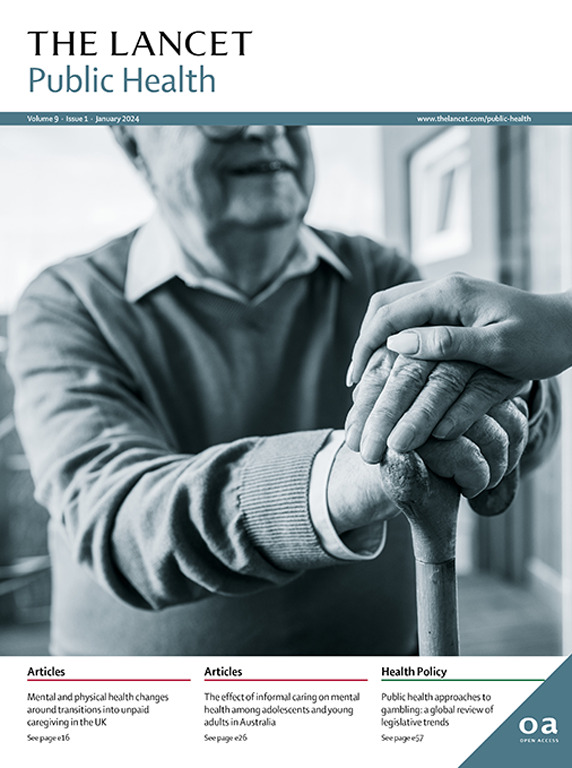Mortality in survivors of adolescent and young adult cancer: progress and opportunities
IF 25.4
1区 医学
Q1 PUBLIC, ENVIRONMENTAL & OCCUPATIONAL HEALTH
引用次数: 0
Abstract
Survivors of adolescent and young adult (AYA) cancer (ie, those aged 15 to 39 years at diagnosis) are a large and growing population. There are more than 2 million survivors of AYA cancer in the USA alone,1 and efforts targeted at reducing late morbidity and mortality are urgently needed. In The Lancet Public Health, Taylor Hughes and colleagues2 evaluate the risk of mortality after a diagnosis of cancer as an AYA over a median of 9 years from diagnosis. Including 24 459 individuals with primary AYA cancer in the Alberta AYA Cancer Survivor Study, they found that all-cause cumulative morality was 35·6% (95% CI 34·6–36·7) at 30 years from diagnosis. This translated to an 11-fold increased risk of mortality in the overall cohort and a 4-fold increased risk of mortality among those who reached 5 years of survival compared with expected mortality in the general population. Cancer recurrence or progression was the main driver of excess mortality, whereas beyond 10-years from diagnosis, subsequent primary neoplasms (SPN) and non-cancer causes of death became more prevalent. Encouragingly, the authors found reductions in mortality for AYAs diagnosed with cancer in more recent decades, largely the result of decreased deaths due to cancer recurrence or progression. These results are similar to those of previous population-based survival analyses using data from the Surveillance, Epidemiology, and End Results database and California Cancer Registry, which found improvements in primary cancer mortality over time, as well as persistently elevated long-term risks of non-cancer and SPN mortality among survivors of AYA cancer.3, 4, 5青少年和青年癌症幸存者的死亡率:进展和机会
青少年和青年(AYA)癌症的幸存者(即诊断时年龄在15至39岁之间的人)是一个庞大且不断增长的人口。仅在美国就有超过200万的AYA癌症幸存者,因此迫切需要努力降低晚期发病率和死亡率。在《柳叶刀公共卫生》杂志上,泰勒·休斯和他的同事评估了癌症诊断后平均9年的死亡风险。在阿尔伯塔省AYA癌症幸存者研究中,包括24459名原发性AYA癌症患者,他们发现在诊断后30年,全因累积道德为35.6% (95% CI为34.6 - 36.7)。与一般人群的预期死亡率相比,这意味着整个队列的死亡率风险增加了11倍,而那些存活5年的人的死亡率风险增加了4倍。癌症复发或进展是高死亡率的主要驱动因素,而在诊断后10年以上,随后的原发性肿瘤(SPN)和非癌症死亡原因变得更加普遍。令人鼓舞的是,作者发现,近几十年来,被诊断为癌症的aya患者的死亡率有所下降,这主要是由于癌症复发或进展导致的死亡率下降。这些结果与先前使用监测、流行病学和最终结果数据库和加州癌症登记处的数据进行的基于人群的生存分析相似,后者发现随着时间的推移,原发性癌症死亡率有所改善,而AYA癌症幸存者的非癌症和SPN死亡率的长期风险持续升高。3 4 5
本文章由计算机程序翻译,如有差异,请以英文原文为准。
求助全文
约1分钟内获得全文
求助全文
来源期刊

Lancet Public Health
Medicine-Public Health, Environmental and Occupational Health
CiteScore
55.60
自引率
0.80%
发文量
305
审稿时长
8 weeks
期刊介绍:
The Lancet Public Health is committed to tackling the most pressing issues across all aspects of public health. We have a strong commitment to using science to improve health equity and social justice. In line with the values and vision of The Lancet, we take a broad and inclusive approach to public health and are interested in interdisciplinary research.
We publish a range of content types that can advance public health policies and outcomes. These include Articles, Review, Comment, and Correspondence. Learn more about the types of papers we publish.
 求助内容:
求助内容: 应助结果提醒方式:
应助结果提醒方式:


